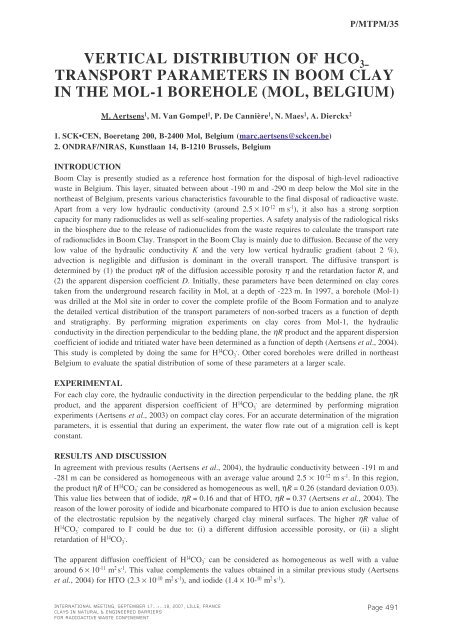Mass Transfer & Porous Media (MTPM) - Andra
Mass Transfer & Porous Media (MTPM) - Andra
Mass Transfer & Porous Media (MTPM) - Andra
You also want an ePaper? Increase the reach of your titles
YUMPU automatically turns print PDFs into web optimized ePapers that Google loves.
P/<strong>MTPM</strong>/35VERTICAL DISTRIBUTION OF HCO 3–TRANSPORT PARAMETERS IN BOOM CLAYIN THE MOL-1 BOREHOLE (MOL, BELGIUM)M. Aertsens 1 , M. Van Gompel 1 , P. De Cannière 1 , N. Maes 1 , A. Dierckx 21. SCK•CEN, Boeretang 200, B-2400 Mol, Belgium ( marc.aertsens@sckcen.be )2. ONDRAF/NIRAS, Kunstlaan 14, B-1210 Brussels, BelgiumINTRODUCTIONBoom Clay is presently studied as a reference host formation for the disposal of high-level radioactivewaste in Belgium. This layer, situated between about -190 m and -290 m deep below the Mol site in thenortheast of Belgium, presents various characteristics favourable to the final disposal of radioactive waste.Apart from a very low hydraulic conductivity (around 2.5 × 10 -12 m s -1 ), it also has a strong sorptioncapacity for many radionuclides as well as self-sealing properties. A safety analysis of the radiological risksin the biosphere due to the release of radionuclides from the waste requires to calculate the transport rateof radionuclides in Boom Clay. Transport in the Boom Clay is mainly due to diffusion. Because of the verylow value of the hydraulic conductivity K and the very low vertical hydraulic gradient (about 2 %),advection is negligible and diffusion is dominant in the overall transport. The diffusive transport isdetermined by (1) the product η R of the diffusion accessible porosity η and the retardation factor R , and(2) the apparent dispersion coefficient D . Initially, these parameters have been determined on clay corestaken from the underground research facility in Mol, at a depth of -223 m. In 1997, a borehole (Mol-1)was drilled at the Mol site in order to cover the complete profile of the Boom Formation and to analyzethe detailed vertical distribution of the transport parameters of non-sorbed tracers as a function of depthand stratigraphy. By performing migration experiments on clay cores from Mol-1, the hydraulicconductivity in the direction perpendicular to the bedding plane, the η R product and the apparent dispersioncoefficient of iodide and tritiated water have been determined as a function of depth (Aertsens et al ., 2004).This study is completed by doing the same for H 14 CO - 3 . Other cored boreholes were drilled in northeastBelgium to evaluate the spatial distribution of some of these parameters at a larger scale.EXPERIMENTALFor each clay core, the hydraulic conductivity in the direction perpendicular to the bedding plane, the η Rproduct, and the apparent dispersion coefficient of H 14 CO - 3 are determined by performing migrationexperiments (Aertsens et al ., 2003) on compact clay cores. For an accurate determination of the migrationparameters, it is essential that during an experiment, the water flow rate out of a migration cell is keptconstant.RESULTS AND DISCUSSIONIn agreement with previous results (Aertsens et al ., 2004), the hydraulic conductivity between -191 m and-281 m can be considered as homogeneous with an average value around 2.5 × 10 -12 m s -1 . In this region,the product η R of H 14 CO 3 - can be considered as homogeneous as well, η R = 0.26 (standard deviation 0.03).This value lies between that of iodide, η R = 0.16 and that of HTO, η R = 0.37 (Aertsens et al., 2004). Thereason of the lower porosity of iodide and bicarbonate compared to HTO is due to anion exclusion becauseof the electrostatic repulsion by the negatively charged clay mineral surfaces. The higher η R value ofH 14 CO 3- compared to I - could be due to: (i) a different diffusion accessible porosity, or (ii) a slightretardation of H 14 CO 3 - .The apparent diffusion coefficient of H 14 CO 3- can be considered as homogeneous as well with a valuearound 6 × 10 -11 m 2 s -1 . This value complements the values obtained in a similar previous study (Aertsenset al., 2004) for HTO (2.3 × 10 -10 m 2 s -1 ), and iodide (1.4 × 10- 10 m 2 s -1 ).INTERNATIONAL MEETING, SEPTEMBER 17...>...18, 2007, LILLE, FRANCECLAYS IN NATURAL & ENGINEERED BARRIERSFOR RADIOACTIVE WASTE CONFINEMENTPage 491
















